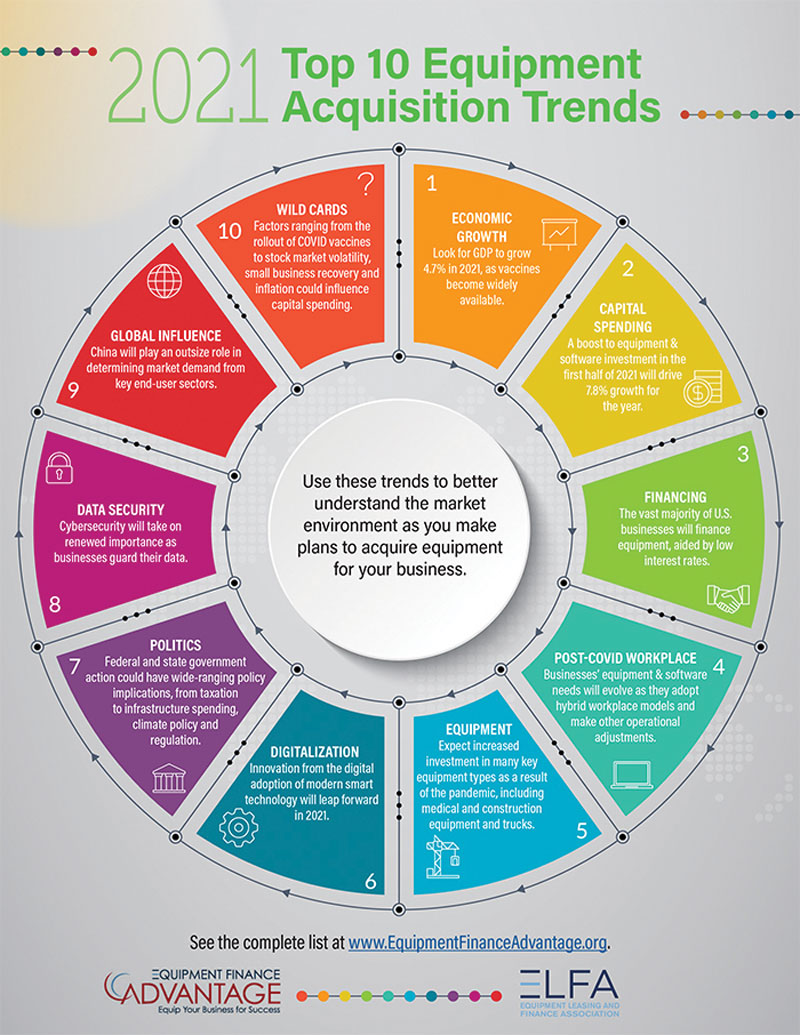The Equipment Leasing and Finance Association (ELFA) which represents the nearly US$1 trillion equipment finance sector, announced its Top 10 Equipment Acquisition Trends for 2021. Given U.S. businesses, nonprofits and government agencies are expected to spend more than US$1.8 trillion in capital goods or fixed business investment (including software) this year, financing a majority of those assets, these trends impact a significant portion of the U.S. economy.
ELFA President and CEO Ralph Petta said, “Not surprisingly, the effects of the COVID pandemic loom large in the list of trends this year. Despite upheaval throughout the economy, equipment acquisition continues to drive supply chains across all U.S. manufacturing and service sectors. Nearly eight in 10 of U.S. businesses use equipment leasing and financing to acquire the productive assets they need to operate and grow. We are pleased to again provide the Top 10 Equipment Acquisition Trends at a time when businesses need to understand the market environment more than ever to make their strategic equipment acquisition plans.”

ELFA distilled recent research data, including the Equipment Leasing & Finance Foundation’s 2021 Equipment Leasing & Finance U.S. Economic Outlook, industry participants’ expertise and member input from ELFA meetings, in compiling the trends shown in the infographic.
For more information, as well as a video highlighting the Top 10 Equipment Acquisition Trends for 2021, visit www.equipmentfinanceadvantage.org/toolkit/10trends.cfm.
According to research in the Global Engineering Plastics Market 2020-2024, the engineering plastics market is poised to grow by US$43 billion between 2020-2024 progressing at a CAGR of 8 percent during this forecast. The report provides a holistic analysis, market size and forecast, trends, growth drivers and challenges, as well as vendor analysis covering approximately 25 vendors.
The report offers an up-to-date analysis regarding the current global market scenario, latest trends and drivers, as well as the overall market environment. The market is driven by the demand for replacements of metals and fiber glass and increasing demand from automobile industry. In addition, demand for replacements of metals and fiber glass is anticipated to boost the growth of the market as well. www.researchandmarkets.com/reports/5204151/global-engineering-plastics-market-2020-2024.
Despite increasingly ambitious targets and a stated desire to meet sustainability targets, companies continue to delay action to implement the necessary changes. How will they close the gap?
Engie Impact surveyed 200 executives of large multinationals to better understand priorities, barriers and key practices that accelerated sustainability transformation.
This research has revealed three known gaps in sustainability execution:


Despite increasingly ambitious targets and a stated desire to meet sustainability targets, companies continue to delay action to implement the necessary changes. How will they close the gap?
Engie Impact surveyed 200 executives of large multinationals to better understand priorities, barriers and key practices that accelerated sustainability transformation.
This research has revealed three known gaps in sustainability execution:
- Managing unknowns. While companies see significant value in quantifying risks and opportunities, few have invested meaningfully in the tools to evaluate them. Sixty-two percent see quantifying opportunities associated to climate change as a near-term priority.
- Engaging suppliers. Companies increasingly see supplier decarbonization as a near-term priority, but they haven’t adopted measures to drive accountability. More than 50 percent of companies see supplier efficiency and renewable energy projects as a near-term priority.
- Redefining finance. While organizations recognize the significant financial impact of sustainability programs, they are slow to adopt innovative finance mechanisms that can accelerate capital deployment. Eighty-three percent see their sustainability strategy impacting corporate revenues and profits.
Read more in the report, Global Executive Survey: Known Gaps and Blind Spots in Corporate Sustainability, which is being released in two parts. Visit www.greenbiz.com/whitepaper/global-executive-survey-known-gaps-and-blind-spots-corporate-sustainability-part-i to download Part I and sign-up to have Part II delivered to your inbox when it’s released.